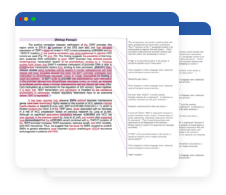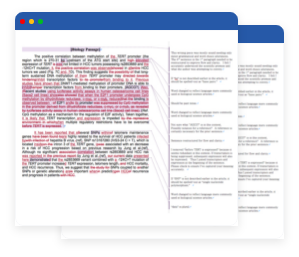English Language Rules for Writers
Learning the rules of grammar, punctuation, sentence structure, and word choice is crucial in creating clear and compelling writing. The Wordvice Language Rules Guide introduces some basic rules of language in English, provides examples, and shows how these language rules apply to academic and scientific writing.
While the last step in the academic writing process is editing and proofreading, all writers should learn how to correct most grammar, punctuation, and style issues on their own before they submit it for professional editing.
Table of Contents
Punctuation Marks
Punctuation marks show how ideas relate to each other and separate parts of sentences and paragraphs. Many common grammar mistakes can be corrected by simply adding, changing, moving, or removing certain punctuation marks.
Understand how to use commas and when to use a colon or semicolon to list items or separate parts of a sentence.
Learn the difference between hyphens and dashes--how they function and how to use them consistently and avoid mixing them up in your writing.
Knowing when to use quotation marks (double or single quotes) in academic writing is important for properly citing sources in your work and avoiding plagiarism. Quotation marks are often confused with apostrophes, which form the possessive with singular and plural nouns. Knowing the difference between these and other basic punctuation marks will make you a more precise writer.
Parentheses and brackets are used to enclose numbers, words, phrases, or sentences considered to be additional information. In academic writing, equations, acronyms, and in-text citations usually go inside the parentheses.
Although question marks are commonly used in academic writing as well as in daily writing, many writers still make mistakes in placement of this important punctuation mark.
Verb Tenses
Verbs are words that indicate what is happening in the sentence--they connect the subject with the object or other parts of the predicate and provide action to the sentence. Ensuring subject-verb agreement is important, as it clarifies who is doing what.
Verb tenses indicate an action in time, and it is crucial to apply the proper verb tenses in academic writing. The verb tenses used in specific sections of a paper often depend both on the journal or publication to which you are submitting and the overall purpose and scope of your writing.
Phrasal verbs combine multiple words (a verb plus a preposition, adverb, or adjective) to create a verb with a new meaning. Phrasal verbs are not often used in academic writing, as they are somewhat informal. The best verbs to use are usually one-word verbs that are more “academic” in nature (i.e., verbs with Latin roots).
Incorrect verb use is one of the most common grammar mistakes writers make. Therefore, it is important to become familiar with multiple verbs that have a similar meaning so that you can choose the right verb (and verb tense) for the given situation.
Active vs. Passive Voice
When writing almost any sentence, authors need to know whether to use active or passive voice. A verb’s “voice” denotes the relationship between the action (or state) that the verb expresses and the subject, direct object, or indirect object identified. When the subject is the agent of the action, the verb is in the active voice. When the subject is the target of the action, the verb is in the passive voice.
Active voice is usually applied when a subject or agent performs an action on another person or object, whereas passive voice allows someone or something else to be the agent. In general, active voice is more direct, and using it allows the writer to convey a clear idea of who is performing the action in a sentence.
Articles (a/an/the)
Knowing how to use articles is a central part of proper English composition. English uses two types of articles: the definite article “the” and the indefinite articles “a” and “an”.
Using incorrect articles for countable and uncountable nouns is one of the most common errors in academic writing. Writers should use the proper article rules to accompany nouns and consider the context in which the articles are being applied to determine which article to use.
Sentence Structure (Word Order Rules)
Basic English word order rules require that a subject be followed by a noun in any sentence. Writers should learn this basic sentence structure and be aware of common word order errors such as sentence fragments and run-on sentences. Sentences should also be varied in structure and length to make writing more readable and compelling.
Keeping a parallel sentence structure is important for ensuring clarity of meaning. Items in a sentence should be listed using consistent word order and phrase structure, as well as be relevant and similar in importance. Learn more about creating parallel sentence structure in academic papers.
Writers should also learn the role that modifiers in English play in describing, quantifying, or limiting parts of the sentence. Dangling and misplaced modifiers are common writing mistakes, even in academic writing.
Word Choice Issues
There are several types of words that writers often use incorrectly. Among these are nouns, pronouns, adverbs, adjectives, prepositions, and conjunctions. Each part of speech has both technical and stylistic rules. Paying attention to these rules during the writing and editing process will help you avoid mistakes in your writing.
Nouns
Nouns refer to persons, animals, places, things, or ideas. Nouns encompass most words used in the English vocabulary, and there are several different types of nouns, including common nouns, proper nouns, concrete nouns, abstract nouns, and collective nouns. It is important to understand how types of nouns are formed since different rules apply to different noun types.
Pronouns
Pronouns are words that take the place of a noun. A pronoun can act as a subject, direct object, indirect object, object of the preposition, or other part of speech and takes the place of any person, place, animal or thing.
There are several types of pronouns: personal pronouns, relative pronouns, demonstrative pronouns, reflexive pronouns, interrogative pronouns, and possessive pronouns. Avoid second-person pronouns in academic writing.
Adjectives
Adjectives are words that modify nouns by giving more information about people, animals, places, things, and ideas. Proper use of adjectives improves the quality of writing by making it more vivid and descriptive.
Ordering adjectives correctly is second nature for most native English speakers, but it may be difficult for non-native English speakers.
Adverbs
Adverbs are words that describe a verb, an adjective, another adverb, or an entire sentence. Adverbs can be used to describe how something is done or to tell how many or how much of something there is. Using adverbs can be helpful to provide a more detailed description in a sentence.
Prepositions
Prepositions are words that describe the relationships between other words. They can describe where something or someone is located (e.g. on, at, in, over, near, above, next to). They can describe relationships of time, space, direction, and many types of abstract or logical connection. There are many different prepositions in English, and most have at least two meanings depending on the context in which they are used.
Conjunctions
Conjunctions are words that connect different parts of a sentence. There are different types of conjunctions with different functions and rules. A conjunction is a word that joins words, phrases, or clauses (e.g., and, but, and or). There are three types of conjunctions: coordinating conjunctions, subordinating conjunctions, and correlative conjunctions.
Common Writing Mistakes
Grammatical errors include all mistakes made in English writing that violate the rules of word order, sentence structure, and spelling. The five most common grammar mistakes are:
- Incorrect determiners
- Incorrect preposition usage or placement
- Subject-verb agreement issues
- Verb usage errors
- Verb tense inconsistencies
Common mistakes in academic writing are often related to a particular article section of a research paper. Writers should be sure to use the correct verb tenses, apply proper data and number formatting, and use appropriate figure and table nomenclature, as well as follow any other guidelines set out by the target journal or publication.










